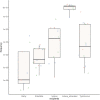Prevalence of 16S rRNA Methylation Enzyme Gene armA in Salmonella From Outpatients and Food
- PMID: 34113329
- PMCID: PMC8186500
- DOI: 10.3389/fmicb.2021.663210
Prevalence of 16S rRNA Methylation Enzyme Gene armA in Salmonella From Outpatients and Food
Abstract
Salmonella is the primary cause of community-acquired foodborne infections, so its resistance to antimicrobials, such as aminoglycosides, is a public health issue. Of concern, aminoglycoside resistance in Salmonella is increasing rapidly. Here, we performed a retrospective study evaluating the prevalence of Salmonella harboring armA-mediated aminoglycoside resistance in community-acquired infections and in food or environmental sources. The prevalence rates of armA-harboring Salmonella strains were 1.1/1,000 (13/12,095) and 8.7/1,000 (32/3,687) in outpatient and food/environmental isolates, respectively. All the armA-harboring Salmonella strains were resistant to multiple drugs, including fluoroquinolone and/or extended-spectrum cephalosporins, and most (34/45) belonged to serovar Indiana. The armA gene of these strains were all carried on plasmids, which spanned five replicon types with IncHI2 being the dominant plasmid type. All the armA-carrying plasmids were transferable into Escherichia coli and Acinetobacter baumannii recipients. The conjugation experiment results revealed that the armA-harboring S. Indiana strains had a relatively higher ability to acquire armA-carrying plasmids. The low similarity of their pulsed field gel electrophoresis patterns indicates that the armA-harboring Salmonella strains were unlikely to have originated from a single epidemic clone, suggesting broad armA spread. Furthermore, the genetic backgrounds of armA-harboring Salmonella strains isolated from outpatients exhibited higher similarity to those isolated from poultry than to those isolated from swine, suggesting that poultry consumption maybe an infection source. These findings highlight an urgent need to monitor the prevalence and transmission of armA-harboring Salmonella, especially S. Indiana, to better understand the potential public health threat and prevent the further spread of these strains.
Keywords: Salmonella; armA; multi-drug resistant; poultry; swine.
Copyright © 2021 Lu, Zeng, Zhang, Wang, Gu, Li, Jin, Xiao, Li, Zhao, Zhou, Li, Xu, Xu and Kan.
Conflict of interest statement
The authors declare that the research was conducted in the absence of any commercial or financial relationships that could be construed as a potential conflict of interest.
Figures



Similar articles
-
Co-production of SFO-1 and DHA-1 β-lactamases and 16S rRNA methylase ArmA in clinical isolates of Klebsiella pneumoniae.J Antimicrob Chemother. 2012 Oct;67(10):2361-6. doi: 10.1093/jac/dks244. Epub 2012 Jul 9. J Antimicrob Chemother. 2012. PMID: 22778158
-
Prevalence of 16S rRNA methylase genes in Klebsiella pneumoniae isolates from a Chinese teaching hospital: coexistence of rmtB and armA genes in the same isolate.Diagn Microbiol Infect Dis. 2009 May;64(1):57-63. doi: 10.1016/j.diagmicrobio.2009.01.020. Epub 2009 Feb 18. Diagn Microbiol Infect Dis. 2009. PMID: 19232867
-
Diverse prevalence of 16S rRNA methylase genes armA and rmtB amongst clinical multidrug-resistant Escherichia coli and Klebsiella pneumoniae isolates.Int J Antimicrob Agents. 2011 Oct;38(4):348-51. doi: 10.1016/j.ijantimicag.2011.04.021. Epub 2011 Jul 2. Int J Antimicrob Agents. 2011. PMID: 21724374
-
First report of 16S rRNA methylase ArmA-producing Acinetobacter baumannii and rapid spread of metallo-β-lactamase NDM-1 in Algerian hospitals.J Infect Chemother. 2014 Nov;20(11):696-701. doi: 10.1016/j.jiac.2014.07.010. Epub 2014 Sep 16. J Infect Chemother. 2014. PMID: 25240726
-
Emergence of Aminoglycoside Resistance Due to armA methylase in Multi-drug Resistant Acinetobacter Baumannii Isolates in a University Hospital in Nepal.J Nepal Health Res Counc. 2016 May;14(33):72-76. J Nepal Health Res Counc. 2016. PMID: 27885285
Cited by
-
The prevalence and distribution of aminoglycoside resistance genes.Biosaf Health. 2023 Jan 6;5(1):14-20. doi: 10.1016/j.bsheal.2023.01.001. eCollection 2023 Feb. Biosaf Health. 2023. PMID: 40078603 Free PMC article. Review.
-
High Carriage of Extended-Spectrum, Beta Lactamase-Producing, and Colistin-Resistant Enterobacteriaceae in Tibetan Outpatients with Diarrhea.Antibiotics (Basel). 2022 Apr 11;11(4):508. doi: 10.3390/antibiotics11040508. Antibiotics (Basel). 2022. PMID: 35453259 Free PMC article.
-
Research Updates of Plasmid-Mediated Aminoglycoside Resistance 16S rRNA Methyltransferase.Antibiotics (Basel). 2022 Jul 7;11(7):906. doi: 10.3390/antibiotics11070906. Antibiotics (Basel). 2022. PMID: 35884160 Free PMC article. Review.
References
-
- Bueno M. F., Francisco G. R., O’Hara J. A., de Oliveira Garcia D., Doi Y. (2013). Coproduction of 16S rRNA methyltransferase RmtD or RmtG with KPC-2 and CTX-M group extended-spectrum beta-lactamases in Klebsiella pneumoniae. J. Antimicrob. Chemother. 57 2397–2400. 10.1128/aac.02108-12 - DOI - PMC - PubMed
LinkOut - more resources
Full Text Sources

